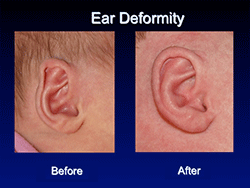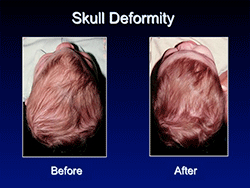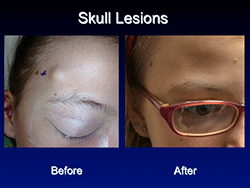
Ear deformities

Cleft Lip and Palate

Pierre Robin Sequence

Hemangioma and other Vascular Malformations

A hemangioma is one of the many types of vascular malformations. Vascular malformations grow steadily throughout the growth of the child. Without treatment, a vascular malformation will not diminish or disappear. Treatments of vascular malformations include appropriate medical management laser therapy for superficial lesions, and surgical removal for deeper lesions.
The management of vascular malformations and hemangiomas is complex and often requires evaluation and treatment by a multidisciplinary team. At FACES, we offer the latest, most innovative treatment to deal with your child’s hemangioma or vascular malformation.
Skull Deformities

In Greek the term “Plagio” is defined as oblique and “cephaly”
means head. A literal translation of deformational plagiocephaly is an “oblique head.” Deformational plagiocephaly arises when constant pressure is applied to the same spot in an infant’s skull. The bones in an infant’s skull are very soft and easily misshapen. This condition can often improve or resolve with conservative management and repositioning techniques. However, when there is little or no improvement with this condition, FACES surgeons utilize Orthomerica’s state of the art STAR scanner, to obtain precise measurements in 1.5 seconds and capture 3D data. Using STAR scanner’s quick, accurate measurements, a custom head band or star band can be made and worn to improve the shape of the head.
Skull and Orbital Tumors

Other Disorders We Treat
Our FACES surgeons also treat the following conditions:
- Treacher-Collins
- 22q.11.2 Deletion Syndrome
- Tumors or deformities of the head, eye, face, neck and jaw
- Skull defects
- Torticollis
- Disorders of the scalp
- Nevus or moles of the head and neck
- Nasal deformities
- Skull base disorders
- Maxiofacial deformities
- Velopharyngeal insufficiency
- Anophthalmic socket
- Eyelid disorder and ptosis
If your child suffers from a pediatric plastic, reconstructive or craniomaxillofacial condition effecting the structures of head, face, eyes or neck please contact us to schedule an appointment.



